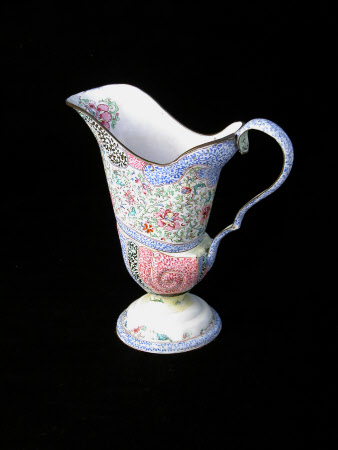Ewer
Category
Metalwork
Date
c. 1740
Materials
Metal and enamel
Measurements
245 mm (Height); 115 mm (Diameter)
Place of origin
Guangzhou
Order this imageCollection
Saltram, Devon
NT 870913.2
Summary
Ewer, painted enamel on copper (sometimes known as ‘Canton enamel’), shaped like an inverted helmet with a domed foot and a strap handle, made in Guangzhou (Canton), c. 1740, decorated in a variety of flower and foliage patterns, in various degrees of stylisation, in pink, yellow, green, blue and black.
Full description
European techniques for applying painted enamel to metalwork were introduced at the imperial Chinese workshops in the 1710s and 1720s and were subsequently also adopted by artisans in Guangzhou producing objects for export (Harrison-Hall 2017). Ewers and basins for the European market were made in both painted enamel and porcelain. A Chinese Imari porcelain ewer and basin, known to have been bought by John Spencer (1708-1746) from the luxury goods merchant Elizabeth Chenevix on 28 January 1741/2 ('A China ewer £1.11s.6d. Febry 3 A Large China Scalop'd Shell Bason £2.12s.6d.'), was sold at Christie’s London, 8 July 2010 (The Spencer House Sale), lot 1013. The outlines of these Chinese export ewers and basins were of Western inspiration, for instance echoing the European practice of mounting nautilus shells on stands (Kerr and Mengoni 2011). Their decoration, however, was influenced by the taste in 18th-century China which favoured the use of contrasting visual registers – more realistic or more stylised, more painterly or more geometric – on the same object, a style exemplified by the controlled and yet infinitely varied decoration of the Qing imperial palaces (Hay 2010). In Britain such ewers and basins would have been used as part of the toilette, or to be placed on the sideboard to enable the washing of hands before or during meals (Kerr and Mengoni 2011).
Provenance
Accepted by HM Government in lieu of inheritance tax and allocated to the National Trust, 1957.
References
Harrison-Hall 2017: Jessica Harrison-Hall, China: A History in Objects, London, 2017, pp. 256-7 Hay 2010: Jonathan Hay, Sensuous Surfaces: The Decorative Object in Early Modern China, London, 2010., pp. 39 & 151 Kerr and Mengoni 2011: Rose Kerr and Luisa E. Mengoni, Chinese Export Ceramics, London, 2011, p. 36
